
Dodging a Bullet with Hurricane Lidia
In the good news department—cuz we could all use some good news these days, right?!—we, along with Tosh & Tikka, and s/v Due West “marked ourselves safe” from last week’s Cat 4 Hurricane Lidia. This is our fourth hurricane experience, and enough is enough… but maybe that’s the price you pay to live in paradise?
A Hurricane Primer
As sailors, we always keep a keen eye on every storm that forms during hurricane season—or any time, for that matter! For those of you who are not weather buffs, here’s a little hurricane primer. Hurricanes in the northern hemisphere spin in a counterclockwise direction, and because they are spinning to the west, it is very rare that they move in an eastward direction.
In the Eastern Pacific Ocean, tropical depressions (including tropical storms and hurricanes) generally start to form off the southern coast of Mexico, near the Gulf of Tehuantepec. This is the skinny part of Mexico—the isthmus between the Caribean Sea and the Pacific Ocean where the wind funnels through. This image below paints a great picture of how storms form—this screenshot taken today could represent the next storm on our horizon…but hopefully NOT.
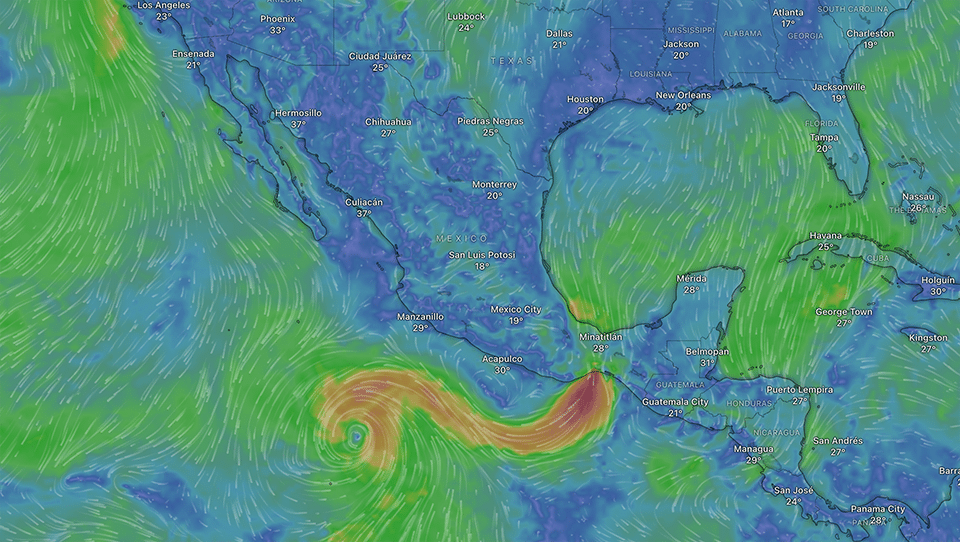
Puerto Vallarta sits at the very end of Banderas Bay, 35 miles from the actual ocean. Banderas Bay is the third largest bay in the world, larger than San Francisco Bay. To the south of Banderas Bay lie the Sierra Madre mountains. At the southwest tip of Banderas Bay is Cabo Corrientes, a step-rising point of land. Cabo Corrientes connects to the Sierra Madre mountains and the height and ruggedness of the terrain help to de-power most hurricanes traveling north before they hit Puerto Vallarta.
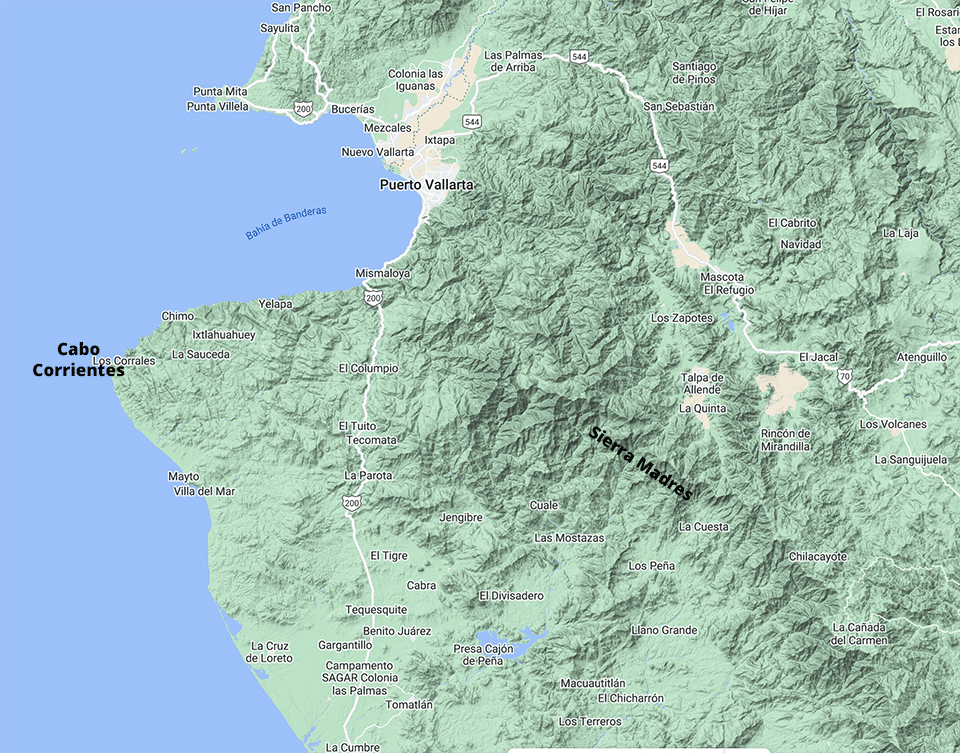
This is the main reason we choose to spend hurricane season in PV. It is considered the safest hurricane hole in all of Mexico. The last hurricane that made a direct hit on Puerto Vallarta was more than 20 years ago when Cat 5 hurricane Kenna clobbered Vallarta in 2002. However, climate change is a real thing and unfortunately, storms are becoming much larger and less predictable these days.
Inside or Outside Revillagigedo Islands?
The general consensus in Mexico says when tropical storms or hurricanes form outside of the Revillagigedo (“Riv-E-haw-he-heedo”) Islands (Isla Socorro is 500 miles off the west coast of Mexico at longitude 110°58’ W), they will typically continue to head west.
However, if tropical storms or hurricanes form inside (between Socorro Island and mainland Mexico), they will most likely travel straight north. These are the storms that can head towards Barra de Navidad, Banderas Bay, Mazatlan, and into the Sea of Cortez (like the other two hurricanes we have had the “pleasure” to experience aboard Due West, Newton in 2016 in the Sea of Cortez and Nora in 2021 in Barra de Navidad). This pattern is most common in mid to late October.
Lidia first formed as a tropical storm outside the Revillagigedo Islands, so we were not too concerned… Initially, Lidia was moving westward, “harmlessly out to sea” as the weather forecasters like to say—which is not always so “harmlessly”, depending on which vessels may be in its path or if it ends up going to Hawaii or elsewhere—it’s not so harmless for them!
Then she sat a couple of hundred miles offshore, spinning around and going nowhere. But suddenly on October 8 Tropical Storm Lidia decided to make a 180° U-turn and head straight back east toward Mexico’s mainland! This is highly unusual for any storm. And was definitely not a good situation for us.
What steered Lidia back toward Mexico’s mainland was a series of low-pressure systems around the US and Mexico that basically sucked her eastward.
Hurricane Lidia
Initially, Lidia was forecast to make landfall north of Vallarta, between San Blas and Mazatlan as a Category 1 Hurricane. But this fickle storm was extremely unpredictable, and with each NOAA weather forecast, her trajectory path dropped more and more southward. Which was really no bueno for us!
Lidia was forecast to be in our vicinity by Tuesday evening, October 10. We are still housesitting at Casa Koda, about two miles from the marina, and Kirk heads to Due West almost daily to work on boat projects while Heidi has client meetings and school courses online. So Kirk spent Sunday and Monday prepping Due West and got her mostly hurricane-proofed, with a few last-minute things to do on Tuesday morning. Plus we still had some hurricane-proofing to do at the house as well.
Meanwhile, we kept our eyes out for every new forecast…

Above: Notice the date and time stamp in the white box above each graphic, and how hurricane Lidia sagged south over the course of the two days of forecasts. PV is marked by a green dot. Also, notice the track in proximity to the Tres Marias islands off the coast of Mexico, north of PV. Originally the Tres Marias were forecast to get a direct hit but Lidia ended up far south of them.

Above: NOAA sometimes puts out hurricane tracks that show eight different international computer models. Sometimes the models concur and sometimes they don’t. The tracks on the left from Oct. 9, show the storm going north of PV whereas the tracks on the right, Oct. 10, show PV getting a direct hit.
When a hurricane is imminent NOAA Weather gives updated forecasts every three hours. So at 3 AM Tuesday morning we woke up to check the latest forecast and saw that Lidia was intensifying, increasing from a Cat 1 to a Cat 3, and her trajectory had slid even further south, now expecting to make a direct hit on Puerto Vallarta—as of that forecast. Yikes!!
Too stressed to fall back asleep, we got up and got going with our day. We Ubered to the marina as soon as it was light out and finished securing Due West to the best of our ability.




Our canvas sun/rain shade cover quickly pulls back and stows lashed to the bimini tubing. On the foredeck, our dinghy is locked and lashed to the deck, and Kirk’s bike is locked to the stantions. Amidships, the main cover is lashed on, and the air conditioner is de-commissioned and stowed under the green canvas cover (also lashed on) next to the full fuel tank for the outboard, with a bag of 5/16″ chain that weighs about 40 lbs on top of it. In the cockpit, the helm cover (badly needs a new zipper!) is lashed onto the helm. Side solar panels are tied down to the rail, and solar panels on top of the bimini are lashed down as well.
Marina Vallarta is completely surrounded by five-story condominium buildings which also act as a buffer to the wind in the marina. So we were counting on them to help dampen the effects of this storm. However, their roof tiles can also become flying projectiles that damage boats—so it can be a trade-off.
Divide and conquer… After we stowed our rain/sun awning, Heidi headed to the grocery store to stock up on food and supplies while Kirk finished up at the marina. Then we met back at Casa Koda to secure everything there, bringing all patio furniture into the living room.
After that, all we could do was wait. And as Tom Petty sings, “The waiting is the hardest part…” Thankfully for us (but sadly not for the folks down along Cabo Corrientes!) Lidia continued to sag south and also continued to strengthen into a Cat 4(!) and the outer bands were forecast to hit PV around 6 PM. The city of Puerto Vallarta had a mandatory shutdown of all businesses by 2 PM Tuesday, and all buses stopped running by 4 PM. Plus they mandated a curfew—no one was allowed outside until 11 AM the following morning. We don’t know how well this would go over in the US where everyone is so concerned with their personal rights, but it definitely helped to save lives here!
The rains here started by about 3 PM on Tuesday afternoon and Lidia made landfall as predicted, about 40 miles south of Vallarta by 6 PM—with 140 mph winds. Thanks to the mountains, helping dissipate the hurricane it is estimated the wind in PV was about a Cat 2 strength (96-110 mph or 83-95 kts) when the outer bands of Lidia hit Vallarta, also around 6 PM.




The top images show the actual route, and where Lydia made landfall. The bottom left image is a satellite photo of the cloud cover (Vallarta as a green X), and the bottom right is an infrared image of the hurricane, with dark red and black being the highest wind speeds (Vallarta as a white X).
The wind and rain were intense, driving water into the windows and sliding glass doors at the house we are housesitting. And howling and whistling so loudly—for a while we really thought the sliding glass patio doors were going to implode. And we actually opened the sliding glass door to the patio about 1”, to let some of the air IN, and relieve the pressure pushing against the glass. The buffeting of the wind against this concrete house was so strong that we felt like the house was moving—like we were aboard a boat! And most of the windows were leaking water in this brand new house, so we were also putting out buckets and towels.


Tikka hid in the bedroom closet, but Tosh was pretty chillax hanging out with us in the living room and sleeping through part of it! Of course, the Internet went out at the beginning of the storm so then we had no good bearing on where the storm was or when it might be over. But thankfully we did not lose power or water… as so many did.
The front of Casa Koda only has small, high windows to let light in, but not see out of, and the back of the house has a high concrete wall around the courtyard, which made it very difficult to tell what was happening outside… Plus it was dark! But by 8 PM the wind has subsided substantially, and even the rain has slowed. Hurricane Lidia left behind about 5.5” of water… little did we know the worst was yet to come in the rain department.
Many of the smaller towns south of Vallarta were badly hit with lots of damage. This includes Mismaloya, Boca, Yelapa, Chimo, Myto, El Tuito, Punta Perúla, Tomitlan, and even as far south as Barra de Navidad. Some of the damage was from the Cat 4 force winds (130-156 mph), and some was from the storm surge. We heard reports of 18’ waves along the coast south of Cabo Corrientes, but we haven’t been able to confirm that.

Wednesday morning dawned, beautiful and clear and we went for a walk around the neighborhood to see how bad things were. We were so shocked to see all the downed trees. One Perota tree a half block away, fell across the road, mostly blocking it.
It was SO heartbreaking to walk the nature trail along Rio Pitillal, where huge old-growth banyan and Perota trees were uprooted and smashed to the ground like matchsticks. And we wondered where the birds go during a hurricane? So many of them must have lost their homes. Over 100 large trees came down around Vallarta in this storm.
Downed trees uprooted and blocked sidewalks, trails, and roads, and downed wires were all over PV. Luckily, in the neighborhood where we are housesitting, most of the utilities are underground, so we didn’t see many downed wires.
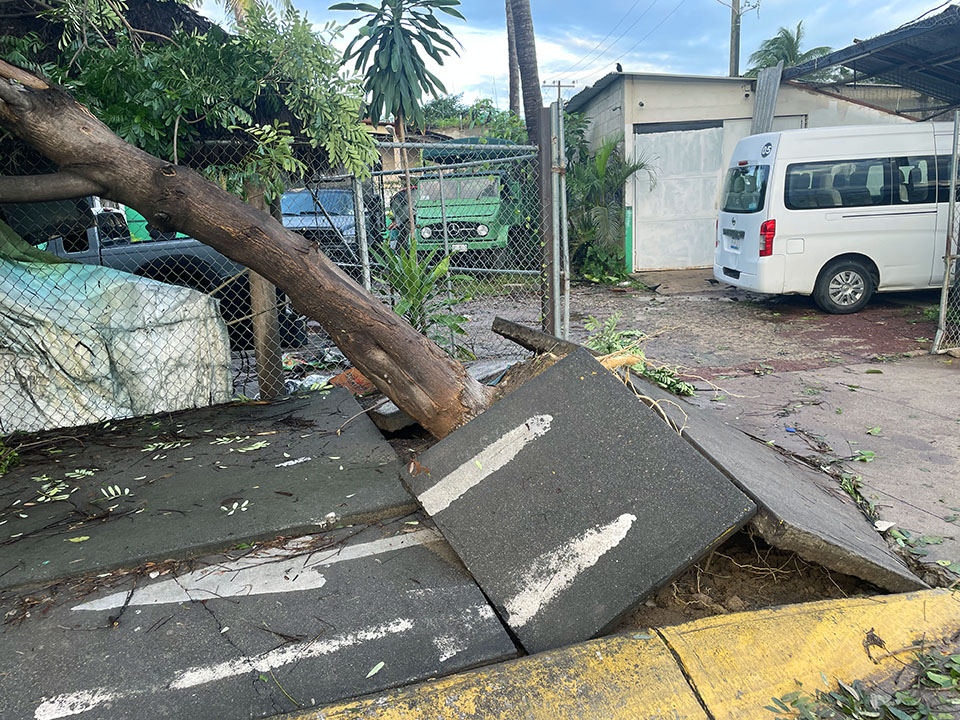


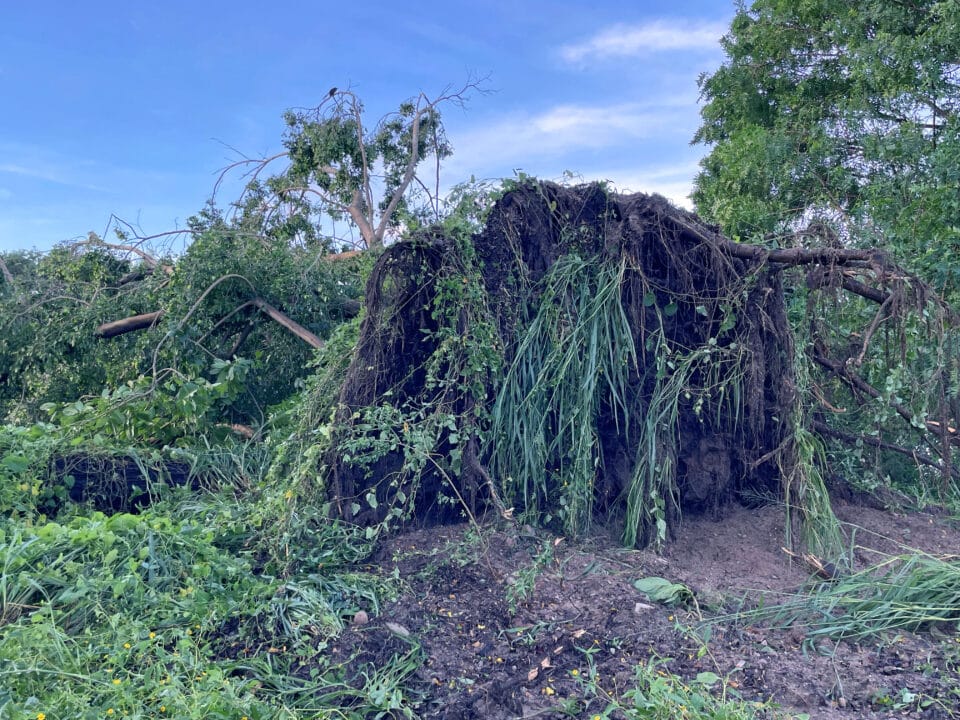






Above: (Before, left) Heidi’s favorite tree with the “tattoo” (ficus) just six weeks ago…(After, right) it crashed down—under the purple arrow you can see some of the tattoo circle markings beneath a layer of sawdust. Thankfully the old banyan survived. Below: someone had already cut off a slab of wood about 6″ x 12″ x 12′ long, and you could cut many, many more boards out of this beautiful old ficus tree.
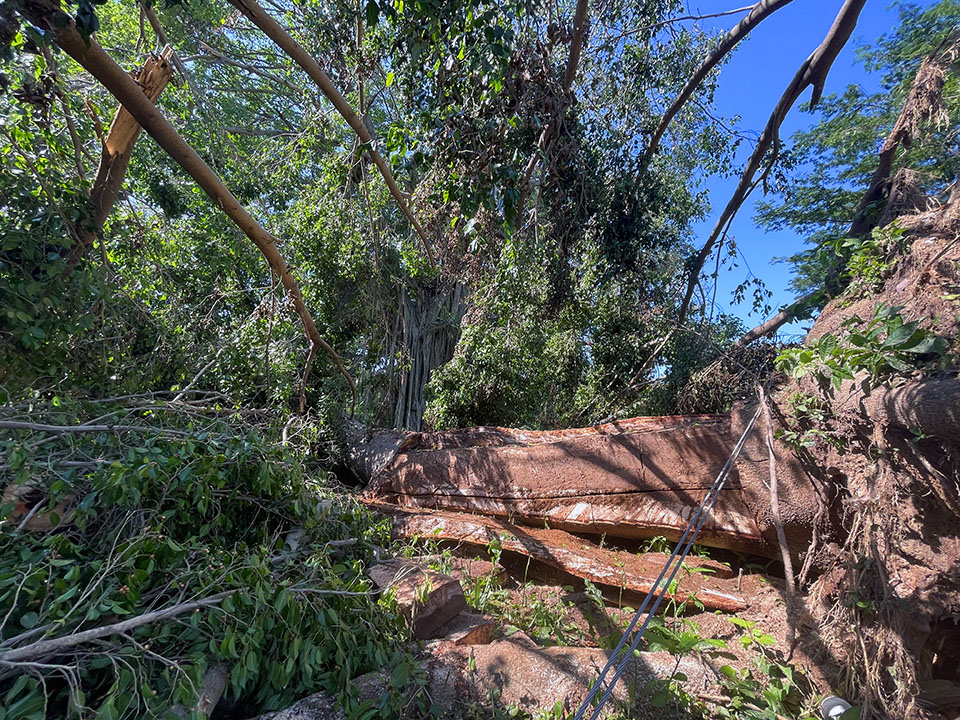
And if you’ve ever been to the Vallarta Botanical Gardens (among the top 10 in the world!), the roof was torn off their restaurant, and there is a lot of downed vegetation there as well. Their employees and trail crews have been hard at work, and we heard they got a new roof on the restaurant in a matter of days!

The Rio Pitillal (low-water photo above from July) was raging higher and faster than we’d seen it before. A great reminder of Mother Nature’s power. Check out the movies below to see that power in action!
As soon as the curfew was lifted, we headed to the Marina to check on Due West. Thankfully she survived just fine without a single scratch. And we were thrilled she was even dry inside—since she has a couple of pesky deck leaks—looks like Kirk covered them well!
The main transformer, (electrical box) at the end of our dock, however, was blown into the water during Lidia, so our dock did not have power. Smartly, we had unplugged our SmartPlug from shore power before the hurricane.
Below, the tall scaffolding-like fishing tournament hanging rack (where the fisherman hang their large Marlins to take trophy photos) also blew over. One boater in the marina said there was a gust of 130 kts, but that doesn’t seem accurate to us.

One of our friends had the tile roof ripped right off his old Mexican home. He rents there and is now haggling with the landlord to try to repair the roof for him. Many people were without electricity, Internet, and/or water for several days. Another friend of ours just got Internet and electricity back on Sunday afternoon, five days after the hurricane. And other friends are still without power and water. Highway 200 south to Myto and Barra de Navidad has been closed due to massive rock slides, hampering recovery efforts for those communities. (photo ©PuertoVallartaDaily.com)
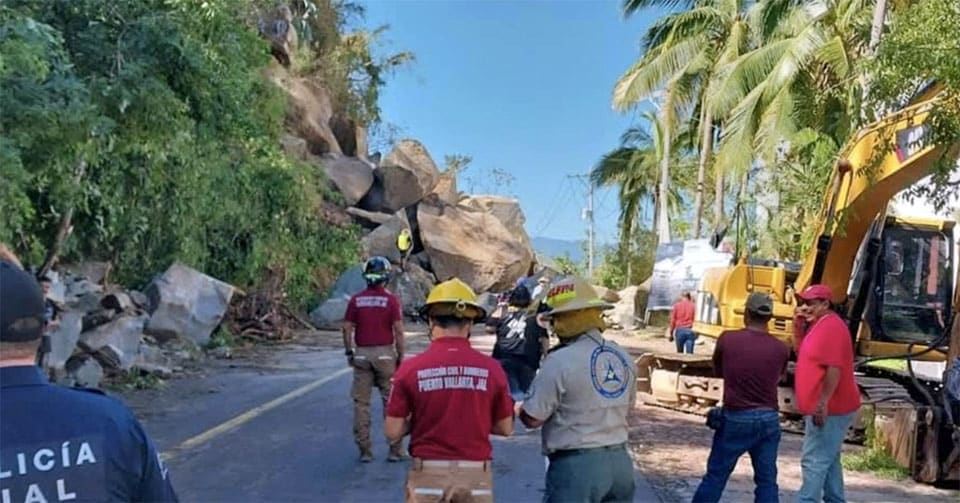



Most of the vegetation cleanup effort is being done by machete and axe. And if there are chainsaws, they are small Ryobi 15″-18” saws—which just can’t cut through the massive trunks. Interestingly, the Mexican Navy (Marinas) seems to be in charge of the cleanup crews. Maybe because there is a Navy base right next to the marina?
But to compound hurricane cleanup efforts, on Thursday around 6 PM we started getting more rain. This deluge was totally unrelated to the hurricane. Since it’s rainy season, it is very common to have thunderstorms late afternoon or early evening and they usually last anywhere from 20-30 minutes to a couple of hours. This one was absolutely crazy—it poured rain as hard as we have ever seen for hours!
At about the same time the deluge started, the municipal water was shut off. We heard that the city shut off all the water to prevent contamination from the overflowing rivers, which seemed pretty smart and forward-thinking. Although we heard some people complaining that they weren’t given enough notice!?!
Kirk had been working on Due West and was trying to catch a bus back to Casa Koda from the marina around 6:30 PM. But with the deluge, buses were few and far between so he tried Uber. They wanted an astronomical sum—four times the normal rate—thankfully, Kirk found a taxi with a reasonable rate.
He explained to the taxi driver (in Spanish), the best route to go because the streets around Casa Koda always flood. But the driver would not listen to Kirk and drove his own way… and sure enough, they got stuck in stalled traffic on flooded streets!
Puerto Vallarta is bisected by three big rivers which were already very full from the hurricane rains. With this new rain added to them, the rivers began to overflow their banks and run down major arterials. And many reports were showing rush-hour cars and buses being washed down streets-turned-to-rivers, as people were trying to climb out of their cars. So scary and dangerous! Someone ingeniously strung a rope from the bus to the phone pole so people could hang on walking through the current. We have never seen anything like this flooding in our eight years in Mexico.

Images ©PuertoVallartaDaily.com
This major intersection has zero traffic lights or stop signs and is frequently the scene of accidents. It also floods like this any time it rains, and you see people just charge on through!
Meanwhile, back in the taxi—two blocks from Casa Koda—traffic came to a complete standstill. So Kirk paid the taxi driver and walked the rest of the way home. Water was already about 6” deep and flowing over the sidewalk pretty quickly, plus it was dark out, which made it trickier to navigate. Thankfully, Kirk made it back OK, if looking like a drowned rat! The next day we learned Puerto Vallarta had received 9.95” of rain in three hours…WOW!


Left: Wednesday morning after Hurricane Lidia, Right: Thursday night during the deluge.
With no idea when the water would be turned back on again (much of the city is still without water a week later now), we put out every bucket, pot, and pan to catch rainwater to use for flushing toilets. Thankfully, we had stocked up on drinking water before the hurricane, so we were not too concerned about that. And our water tanks on Due West were full so we could get water there if we needed to.
Oddly two days later, the rest of the neighbors had their water back on, but we still did not, and we could not figure out why. The owners of Casa Koda called their handyman to come over and help troubleshoot. And what he found shocked us. Inside the utility closet in the back courtyard pool area, the main water supply valve to the house had been turned off. However, no one had been in that utility closet since before the hurricane. And it is in a locked courtyard that no one has access to except us. And we did not even know there was a water valve there! There are a couple of geckos hanging out in there… Were they strong enough to turn the valve and shut the water off?!? LOL. We have no idea how the water valve got turned off?? But thankfully we have running water again. That will forever remain a mystery!
All that rain also shorted out the front doorbell. And for the next four hours after the rain stopped, the doorbell rang non-stop (and it is very loud!) Finally, it quit working altogether. However, we’ve had a few power outages over the last few days, and every time the power comes back on, the doorbell rings! Ding-Dong…then it stops working again. Then last night it started ringing in the middle of the night again. So today we unscrewed and opened up the doorbell box, and it was all wet inside. So we’re leaving it open to hopefully dry out. And maybe it won’t ring tonight!


This beautiful horse pasture-turned-duck-pond after the deluge, is right next to the river walk.
After hurricane Lidia and the subsequent rain storm… Vallarta looks like she has been pressure washed, and is quite clean and sparkly in spite of all the downed vegetation everywhere. Mexicans are SO resourceful, and everyone seems to be helping each other out, and life is getting back to normal.
However, so many are still very much in need of help. Some of you have asked how you can help support Vallarta in the recovery efforts. The best we can recommend is to make a donation to the Vallarta Food Bank. Not only are they supplying food to those in need, but they are also set up to supply household goods, clothing, bedding, as well as tools (machetes, buckets, ladders, etc. ) for maintenance and repair. They are a fantastic non-profit organization, and your dollar goes far with their buying power. Please consider making a donation online here.
Hurricane season isn’t officially over until November 30 (like the weather gods read our calendar?!)—we still have 6+ weeks to go. As of today, Tropical Storm Norma has just formed and appears to be moving due north, with Cabo San Lucas in her sights—but after Lidia’s about-face, we’re not taking any chances. At least Due West is all prepped, and we know where to put out towels to mitigate leaks at Casa Koda.


Fun with friends! Breakfast with the Sharpies: Corinne (The Shipboard Chef) & Pat, and lunch with the “BonJohnnys”, John & Boni.
We are grateful our ol’ sailing pals Boni & John have moved from La Paz to PV, and love getting together with them. (They and their cats were our hurricane buddies during Hurricane Newton!) As a sidebar, they are owners of Ingenium Books, the publishers of Heidi’s Food, Mood, & Gratitude Journal.
And before Hurricane Lidia, our good friends (and waaaaay-back to Corliss Street, Wallingford neighbor), Pat & Corinne came to visit us for a few days. Our Nephew Tate and a couple of Seattle-area friends will be visiting PV later this month and in early November, to take in Dia de Los Muertos festivities. So we’re excited to see all of them as well. And if you’ve never seen the movie Coco, we highly recommend it, to give you a better understanding of this wonderful Mexican custom, Dia de Los Muertos.
We will be finished with our house-sitting gig and back aboard Due West by early November and plan to set sail south for Barra de Navidad again by early December. And if all the stars align, we’ll hang out down south for a few months, then start sailing back north for La Paz, Loreto, and the Sea of Cortez in the spring, before returning to PV by June for the next hurricane season. Rinse and repeat. As always, our plans are written in sand at low tide. Stay safe all you sailors!

Wow what a harrowing experience. You document it so thoroughly. Appreciate the deep weather dive. Glad everyone, including Due West is ok.
HI GUYS
What an amazing documentary. I was riveted by your drama. Thanks for keeping us in your loop. Much love and hugs to you.
Thanks for sharing your Hurricane experience, also a joy to read about your adventures. Take care
Mis Amigos, como le van. You should submit this real life experience to the NY Times travel section. I enjoyed your writing and factual presentation on Hurricanes and your human experience. Of course knowing you and following your journeys over the years made it that much richer.
Nancy y yo vivemos in Patagonia por 6 meses Octobre a Abril.
Abrazos y Que la vya bien
Wow. What an awesome report you two. Good to see the real news on all of this. Such a bad storm but I guess could’ve been worse. Glad to hear Due West made it through okay. Also good news a lot of the boats in the marinas made it safely. Was worried about the ones at LaCruz but I guess only minor damage. Hope to see you again Kirk & Heidi first week of November.
Wow! What a ride! So glad you’re safe! ❤️😘❤️